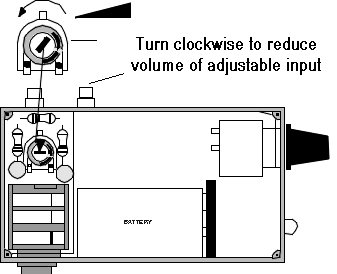After many years of searching for the perfect harmonica microphone, I can safely say that I have used hundreds of different styles and brands of microphones. Some were meant for other uses such as the vintage “bullet” style mics. Even though they were designed, originally for dispatching taxis or amateur radio operators, they provided a sound that was soon associated with the amplified harmonica. These mics are still considered by many to be the only microphone suitable for such use. Their manufacturers were slow in recognizing their potential for use by professional and amateur musicians, but eventually submitted to pressure and started to ”reissue” these mics labeled as “harmonica microphones”. Although the original versions of these microphones were superior in sound to the new reissues, many are sold to novice harp players and to those pros who do not have access to the, better, vintage mics. Unfortunately, the vintage models of the bullet style mic, as well as the new reissue mics are all subject to the harmonica players worst nightmare, feedback…. Only the best players are able to deal with this problem and even they will tell you that dealing with it took time, effort and expense.
Aside from the issue of feedback, there is the problem with the size of the bullet style mics. They are like holding a tennis ball in your hand with the harmonica. This obstacle is not only uncomfortable, but also prevents many players from attaining the acoustical chamber their hands should develop around the harmonica. Much of the desired “honk” harp players seek is due to trapping the harmonica’s sound in their hands with the microphone. The harp player’s control over the amount of air that escapes from this chamber is crucial in developing and maintaining the tone that is truly the individual player’s signature sound. The large size of these bullet style mics hinders the development of the sound we all seek as players of the amplified harmonica.
There are many microphones that are made specifically for the harmonica player. These are not the so-called “reissue” styles that we have just discussed, but rather designs that were made with the harmonica in mind from their out-set. These designs vary tremendously in style, size, options and price. Their qualities may or may not impress the harp player that is seeking the tone and feedback control that many of us look for. Some still tend to be large in size so that holding them comfortably is an issue. Other designs involve attaching the mic to the harmonica, which may not be practical for those of us who change harps to accommodate key changes in a band situation. Still, others just don’t measure up to our expectations and we continue to either live with a sound that is less than satisfying, or go on trying whatever we can to reach that ”Holy Grail” of tone, volume and control.
There are still other options for the amplified harmonica player when it comes to the choice of microphones. The late, great Paul Butterfield used a vocal mic known as a 545s. Incredible tone and increased control over feedback at higher volume levels were trademarks of this unusual microphone choice. This microphone also had an on-off switch that enabled the player to turn off the mic when it was not being played through. This minimized the feedback potential. The 545s was, however, a vocal mic and despite its benefits it is heavy, awkward to hold and since they are no longer made, they are very hard to find.
If you were to ask every experienced harmonica player, “What is your choice in harp mics?” you would get a variety of answers. Many might agree on the vintage bullet mics and some might even come up with an idea or type of mic you haven’t heard of. No matter what has been said about the harmonica mics of the past or the reissue versions these mics; No matter what you think you know about the perfect harmonica mic; No matter what you’ve tried and been disappointed with; No matter what your level of playing experience; No matter who your Daddy is!
The Microvox Harmonica Microphone will blow you away!
Before I bought my first Microvox Harmonica Microphone, I had problems with feedback, microphone reliability, and unexpected tone and volume problems from one gig to the next. Each venue we played in, the sound of my rig was different. Some better than before, some worse and never what I had planned on. The vintage microphones I used were unreliable and very delicate. If they worked I was pleased and when they failed or I could not “dial them in” I was miserable and my sound suffered. Since all the microphones I used seemed to present problems, I looked for the answer in my amplifiers. I tried dozens of vintage and reissue amps as well as some of the expensive “boutique” harp amps trying to find that balance of volume, tone and overall “growl”. Like most harp players, I put up with the good and bad of it all, believing that someday I would find “The Sound”.
I decided that I would invest in an expensive, custom made amp that was designed specifically for harp players. It had 100 watts of power and was twice the amp that I was currently playing through. The advertisements for the amp promised that it was powerful enough for any gig situation. When I saw it in action, I was so impressed that I began saving for its nearly $2000.00 price tag. I was sure that the answers to my harp playing problems were on their way out with this new amp on its way in. The night before I was going to send in my deposit for this new amp, we were playing one of our largest venues. The place was packed and we were opening for one of the big names in blues. I was not sure what mic to use and none of my mics were so great that one stood out over the other. I picked my unused Microvox Harmonica Microphone out of my gig bag and hooked it up for a sound check before the gig. I had received it about a week before and had not even unwrapped it yet. After blowing just a few notes through my Microvox Microphone I was in love! I could not believe that it was me blowing those notes. The “honk” was there, the “growl” was there, and the volume was intense! My guitar player asked me at the end of that evening why I was going to buy a 100 watt amp for $2000.00 when I was getting the sound and volume that I was getting now with this new mic. I never ordered that amp and through gig after gig, to this day, I have not been sorry.
The Microvox Harmonica Microphone is about the size of a pea. It is covered in a rugged rubber sleeve and attached to a thin lead about 3 ½ ft. long. The other end of the lead is sturdily attached to a RCA type, gold tipped, male plug. The flexibility and strength of this lead are only the beginning of this microphone’s many incredible features.
The RCA plug is then attached to a belt mounted “PSU” (power supply unit) by means of either one of two RCA female connectors, built right into the sturdy, die cast PSU housing. One of the female inputs is factory set for your volume control. The other input can be adjusted internally so that your volume control starts and stops where you want it. You choose which one is best for you or change between them as your mood or gig suggests. The volume/on-off knob on the top of the PSU controls each of the inputs. When the unit is on the, easy to see, green LED lights up and it goes off when you switch the knob to the off position. The PSU is about the size of a pack of cigarettes.
You can attach your PSU to your amplifier with a standard ¼ in. guitar cord. There is a female ¼ in. receptacle in the side of the PSU so that you can choose the length of cord you want between you and your amplifier. After adjusting the controls on your amp you can step away from it and control you volume from your PSU. The ease of operation is incredible.
You’ll notice that your amp is now able to put out so much more sound than with any other microphone, without the feedback problems you faced before. The power that this mic pushes through your amp is simply unbelievable.
Should you mic your rig through the PA?
There is a lot of discussion among harmonica players about whether or not you should mic your amp through the PA or not. I don’t think there is any correct answer to this question, but rather a number of opinions, all of which bare some merit. I personally don’t like to run through the PA, because I don’t want anyone determining my volume and tone but me. Guitar players and other band members don’t ask me to dial in their amps and I don’t want someone only familiar with another instrument dialing in the sound of my harp. It is, as I said before, a matter of opinion and each player needs to find his sound and build towards bettering it. In some cases harp players choose smaller, less potent amps so that they can be turned up and over-driven to produce that type of signature tone. In this situation it is probably necessary to use the boost through the PA, mentioned here, to achieve enough volume to be heard with fellow band members. The Microvox Harmonica Microphone allows for any application of amplifier volume control. It works when the player’s amplifier stands alone, providing a variety of sounds from “clean” to “violently overdriven”, or it works when the player’s amp is driven into a mic and then through the PA, again offering everything from “clean virgin notes” to “maniacal distortion. The Microvox Harmonica Microphone will meet or exceed your tone and volume expectations no matter what you are using now.
The tone that most harp players are looking for is available to all of us. It is the sound that a harmonica makes when the air leaving the harp is controlled by our hands and then amplified through our choice of amps. This tone is most easily achieved when our hands don’t have to hold a large microphone as well as the harmonica. The “tone chamber” created by our hands is the beginning of the amplified tone we all seek. Now, imagine that chamber without the “tennis ball sized” microphone in it that most players insist on using. That is the beauty of the Microvox Harmonica Microphone, because as I said before, the microphone is about the size of a pea. You will hardly know it’s in your hands until you blow a few notes.
A Final Note...
After playing harp for many years and searching for that awesome tone that always seems to belong to someone else, I hesitate to say that I have found the answer. It would not be fair of me to tell other harmonica players that this is the “cure all” microphone that will change your life overnight. There is no substitute for practice, shared knowledge, and love of the instrument, when it comes to honing one’s skill in harmonica playing. I do believe, however, that if you are seeking that sound which you have been unable to find, this microphone will make an incredible difference in your playing. When the mechanics of playing music run smoothly the musician can then concentrate on the content of the music rather than the vehicle that delivers it.
Harmonically yours, Silk Stegner 
